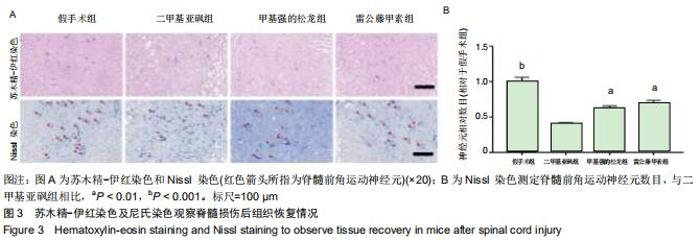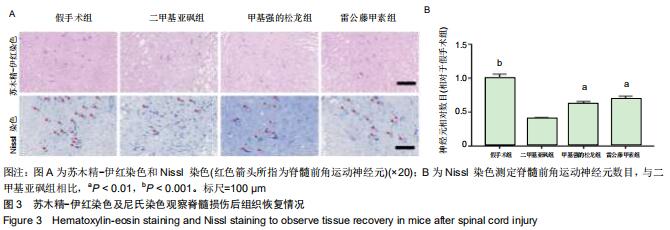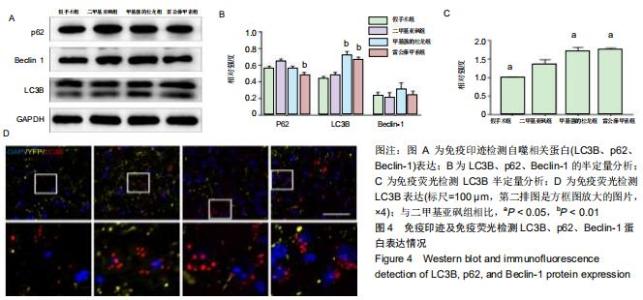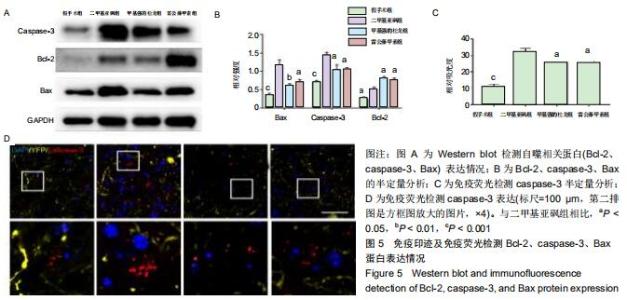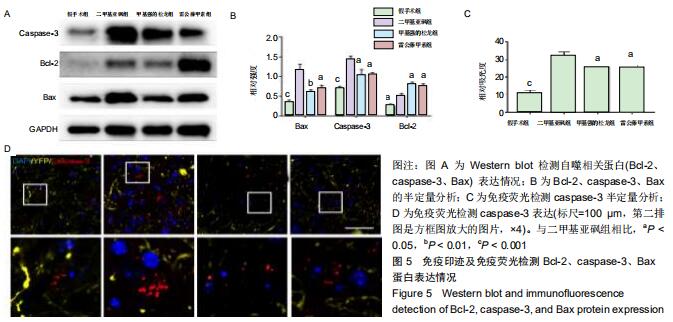Chinese Journal of Tissue Engineering Research ›› 2020, Vol. 24 ›› Issue (35): 5650-5655.doi: 10.3969/j.issn.2095-4344.2886
Previous Articles Next Articles
Triptolide improves spinal cord injury recovery via upregulation of autophagy and inhibition of apoptosis in Thy-YFP transgenic mice
Zhu Ning, Yang Xinming, Ruan Jianwei
First Affiliated Hospital of Hebei North University, Zhangjiakou 075000, Hebei Province, China
-
Received:2019-12-10Revised:2019-12-14Accepted:2020-03-03Online:2020-12-18Published:2020-10-17 -
Contact:Yang Xinming, Master, Professor, First Affiliated Hospital of Hebei North University, Zhangjiakou 075000, Hebei Province, China -
About author:Zhu Ning, Master candidate, Physician, First Affiliated Hospital of Hebei North University, Zhangjiakou 075000, Hebei Province, China -
Supported by:2011 Medical Science Research Key Project of Hebei Provincial Department of Health, No. 20110176; 2013 Innovative Talent Cultivation Foundation of Hebei North University, No. CXRC1322
CLC Number:
Cite this article
Zhu Ning, Yang Xinming, Ruan Jianwei. Triptolide improves spinal cord injury recovery via upregulation of autophagy and inhibition of apoptosis in Thy-YFP transgenic mice[J]. Chinese Journal of Tissue Engineering Research, 2020, 24(35): 5650-5655.
share this article
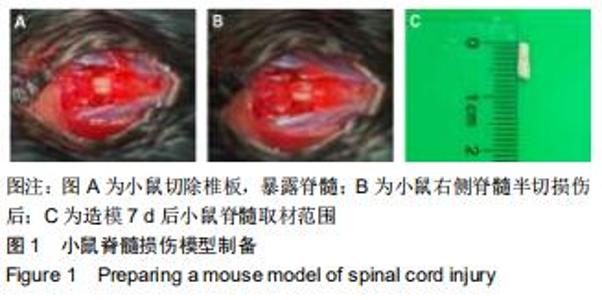
1.4.2 脊髓损伤动物模型制备 实验采用右侧脊髓半切模型[12]。含体积分数1.5%异氟烷的氧气麻醉小鼠,取俯卧位固定在手术台上。以T12段背部正中为中心消毒并做切口,长30 mm,切开皮肤下组织,沿椎体逐层暴露至椎板,在T12段水平行椎板切除术后暴露脊髓,使用显微外科剪横断右侧脊髓,然后选用11号刀片划过脊髓切口确保右侧脊髓彻底离断,最后逐层缝合皮肤并消毒。以上操作均在体视显微镜下进行,假手术组只进行椎板切除术,不损伤脊髓(图1A,B)。 LI,YANG等[5]探讨了雷公藤甲素(剂量为0.2 mg/kg)对大脑中动脉闭塞的神经保护作用,实验参照该剂量,雷公藤甲素组术后立即腹腔注射雷公藤甲素溶液[0.2 mg/(kg·d)],二甲基亚砜及假手术组小鼠术后立即腹腔注射等量5%二甲基亚砜-生理盐水溶液,连续处理7 d;根据国家急性脊髓损伤研究(NASCIS)脊髓损伤后激素冲击治疗指南和以前报道的剂量给药,甲基强的松龙组小鼠在术后30 min,6 h和24 h腹腔注射甲基强的松龙(30 mg/kg)[5,12]。术后每天膀胱按摩2次,直至小鼠自主排尿功能恢复,术后3 d给予青霉素100 U/(g·d)腹腔注射防止感染。除行为学检测的小鼠外,其余小鼠均在术后第7天取材,以损伤处为中心取直径约0.5 cm的脊髓组织用于后续实验(图1C)。 "
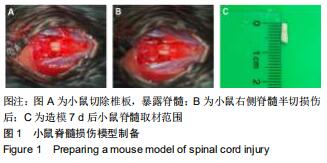
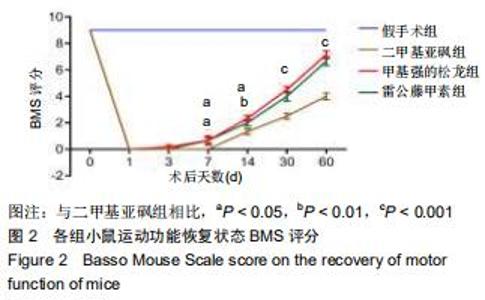
2.2 雷公藤甲素促进脊髓损伤后运动功能 采用Basso Mouse Scale(BMS)评分评估术后不同时间点(0,1,3,7,14,30和60d)各组小鼠脊髓损伤后的右后肢功能恢复情况(图2)。组内比较:假手术组小鼠在手术后显示正常功能(BMS评分为9);二甲基亚砜组、甲基强的松龙组及雷公藤甲素组损伤后不同时间点BMS评分均明显降低,随着时间延长,BMS评分逐渐升高,组内不同时间点比较差异有显著性意义(P值均< 0.001)。组间比较:二甲基亚砜,雷公藤甲素和甲基强的松龙组中的小鼠术后1 d显示右下肢完全瘫痪(BMS评分为0)。术后第3天,甲基强的松龙组有少量小鼠能够进行轻微踝关节活动,但各组间BMS评分差异无显著性意义(P > 0.05)。术后第7,14,30和60天,甲基强的松龙和雷公藤甲素组的BMS评分显著高于二甲基亚砜组(P均< 0.05),但甲基强的松龙组和雷公藤甲素组的小鼠之间评分差异无显著性意义(表1)。BMS评分结果提示,脊髓损伤后运动功能明显降低,肢体运动障碍明显;甲基强的松龙及雷公藤甲素治疗均有助于脊髓损伤后神经功能恢复。 "
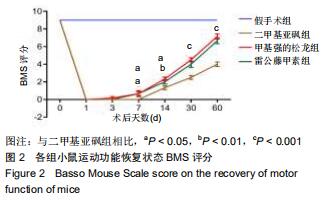
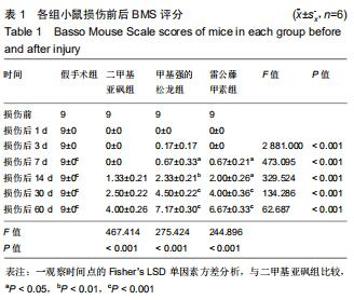
2.2 雷公藤甲素促进脊髓损伤后运动功能 采用Basso Mouse Scale(BMS)评分评估术后不同时间点(0,1,3,7,14,30和60d)各组小鼠脊髓损伤后的右后肢功能恢复情况(图2)。组内比较:假手术组小鼠在手术后显示正常功能(BMS评分为9);二甲基亚砜组、甲基强的松龙组及雷公藤甲素组损伤后不同时间点BMS评分均明显降低,随着时间延长,BMS评分逐渐升高,组内不同时间点比较差异有显著性意义(P值均< 0.001)。组间比较:二甲基亚砜,雷公藤甲素和甲基强的松龙组中的小鼠术后1 d显示右下肢完全瘫痪(BMS评分为0)。术后第3天,甲基强的松龙组有少量小鼠能够进行轻微踝关节活动,但各组间BMS评分差异无显著性意义(P > 0.05)。术后第7,14,30和60天,甲基强的松龙和雷公藤甲素组的BMS评分显著高于二甲基亚砜组(P均< 0.05),但甲基强的松龙组和雷公藤甲素组的小鼠之间评分差异无显著性意义(表1)。BMS评分结果提示,脊髓损伤后运动功能明显降低,肢体运动障碍明显;甲基强的松龙及雷公藤甲素治疗均有助于脊髓损伤后神经功能恢复。 "
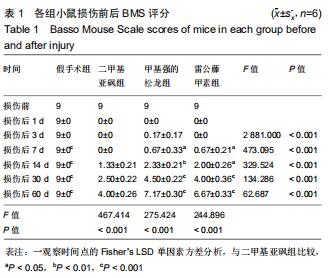
|
[1] ZHOU J, HUO X, BOTCHWAY BOA, et al. Beneficial Effects of Resveratrol-Mediated Inhibition of the mTOR Pathway in Spinal Cord Injury. Neural Plast. 2018;2018:7513748.
[2] GUO Y, WANG F, LI H, et al. Metformin Protects Against Spinal Cord Injury by Regulating Autophagy via the mTOR Signaling Pathway. Neurochem Res. 2018;43(5):1111-1117.
[3] RONG Y, LIU W, LV C, et al. Neural stem cell small extracellular vesicle- based delivery of 14-3-3t reduces apoptosis and neuroinflammation following traumatic spinal cord injury by enhancing autophagy by targeting Beclin-1. Aging (Albany NY).2019;11(18):7723-7745.
[4] LI Y, JONES JW, MC CHOI H, et al. cPLA2 activation contributes to lysosomal defects leading to impairment of autophagy after spinal cord injury. Cell Death Dis.2019;10(7):531.
[5] LI W, YANG Y, HU Z, et al. Neuroprotective effects of DAHP and Triptolide in focal cerebral ischemia via apoptosis inhibition and PI3K/Akt/mTOR pathway activation. Front Neuroanat. 2015;9:48.
[6] SU Z, YUAN Y, CAO L, et al. Triptolide Promotes Spinal Cord Repair by Inhibiting Astrogliosis and Inflammation. Glia.2010;58(8):901-915.
[7] SEIRA O,LIU J,ASSINCK P,et al.KIF2A characterization after spinal cord injury.Cell Mol Life Sci.2019;76(21):4355-4368.
[8] VIDAL PM, ULNDREAJ A, BADNER A, et al. Methylprednisolone treatment enhances early recovery following surgical decompression for degenerative cervical myelopathy without compromise to the systemic immune system. J Neuroinflammation. 2018;15(1):222
[9] TANG P, ZHANG Y, CHEN C, et al. In Vivo Two-Photon Imaging of Axonal Dieback, Blood Flow and Calcium Influx withMethylprednisolone Therapy after Spinal Cord Injury.Sci Rep. 2015;5:9691.
[10] DRUSCHEL C, SCHASER KD, SCHWAB JM. Current practice of methylprednisolone administration for acute spinal cord injury in Germany: a national survey. Spine (Phila Pa 1976).2013;38(11): E669-E677.
[11] LIN Y, LI C, LI J, et al. NEP1-40-modified human serum albumin nanoparticles enhance the therapeutic effect of methylprednisolone against spinal cord injury. J Nanobiotechnology.2019;17(1):12.
[12] TANG P, ZHANG Y, CHEN C, et al. In Vivo Two-Photon Imaging of Axonal Dieback, Blood Flow and Calcium Influx withMethylprednisolone Therapy after Spinal Cord Injury.Sci Rep. 2015;5:9691.
[13] ALLAHDADI KJ, DE SANTANA TA, SANTOS GC, et al. IGF-1 overexpression improves mesenchymal stem cell survival and promotes neurological recovery after spinal cord injury. Stem Cell Res Ther.2019;10(1):146.
[14] SILVA NA, SOUSA N, REIS RL, et al. From basics to clinical: a comprehensive review on spinal cord injury. Prog Neurobiol.2014;114: 25-57.
[15] WU J, LIPINSKI MM. Autophagy in Neurotrauma: Good, Bad, or Dysregulated. Cells. 2019;8(7). pii: E693.
[16] HU G, GONG X, WANG L, et al. Triptolide Promotes the Clearance of alpha-Synuclein by Enhancing Autophagy in Neuronal Cells.Mol Neurobiol. 2017;54(3):2361-2372.
[17] ERLICH S, SHOHAMI E, PINKAS-KRAMARSKI R. Neurodegeneration Induces Upregulation of Beclin 1. Autophagy.2006;2(1):49-51.
[18] RONG Y, LIU W, WANG J, et al. Neural stem cell-derived small extracellular vesicles attenuate apoptosis and neuroinflammation after traumatic spinal cord injury by activating autophagy. Cell Death Dis. 2019;10(5):340.
[19] RONG Y, LIU W, LV C, et al. Neural stem cell small extracellular vesicle-based delivery of 14-3-3t reduces apoptosis and neuroinflammation following traumatic spinal cord injury by enhancing autophagy by targeting Beclin-1. Aging (Albany NY).2019;11(18): 7723-7745.
[20] SARASWAT OHRI S, BANKSTON AN, MULLINS SA, et al. Blocking Autophagy in Oligodendrocytes Limits Functional Recovery after Spinal Cord Injury.J Neurosci. 2018;38(26):5900-5912.
[21] ZHAO H, CHEN S, GAO K, et al. Resveratrol protects against spinal cord injury by activating autophagy and inhibiting apoptosis mediated by the SIRT1/AMPK signaling pathway. Neuroscience.2017;348: 241-251.
[22] LI Z, CHEN T, CAO Y, et al. Pros and Cons: Autophagy in Acute Spinal Cord Injury. Neurosci Bull.2019;35(5):941-945. |
| [1] | Min Youjiang, Yao Haihua, Sun Jie, Zhou Xuan, Yu Hang, Sun Qianpu, Hong Ensi. Effect of “three-tong acupuncture” on brain function of patients with spinal cord injury based on magnetic resonance technology [J]. Chinese Journal of Tissue Engineering Research, 2021, 25(在线): 1-8. |
| [2] | Zhang Chao, Lü Xin. Heterotopic ossification after acetabular fracture fixation: risk factors, prevention and treatment progress [J]. Chinese Journal of Tissue Engineering Research, 2021, 25(9): 1434-1439. |
| [3] | Jiang Hongying, Zhu Liang, Yu Xi, Huang Jing, Xiang Xiaona, Lan Zhengyan, He Hongchen. Effect of platelet-rich plasma on pressure ulcers after spinal cord injury [J]. Chinese Journal of Tissue Engineering Research, 2021, 25(8): 1149-1153. |
| [4] | Wu Xun, Meng Juanhong, Zhang Jianyun, Wang Liang. Concentrated growth factors in the repair of a full-thickness condylar cartilage defect in a rabbit [J]. Chinese Journal of Tissue Engineering Research, 2021, 25(8): 1166-1171. |
| [5] | Li Jing, Xie Jianshan, Cui Huilin, Cao Ximei, Yang Yanping, Li Hairong. Expression and localization of diacylglycerol kinase zeta and protein kinase C beta II in mouse back skin with different coat colors [J]. Chinese Journal of Tissue Engineering Research, 2021, 25(8): 1196-1200. |
| [6] | Chen Jiming, Wu Xiaojing, Liu Tianfeng, Chen Haicong, Huang Chengshuo. Effects of silymarin on liver injury and bone metabolism induced by carbon tetrachloride in mice [J]. Chinese Journal of Tissue Engineering Research, 2021, 25(8): 1224-1228. |
| [7] | Geng Qiudong, Ge Haiya, Wang Heming, Li Nan. Role and mechanism of Guilu Erxianjiao in treatment of osteoarthritis based on network pharmacology [J]. Chinese Journal of Tissue Engineering Research, 2021, 25(8): 1229-1236. |
| [8] | Tan Jingyu, Liu Haiwen. Genome-wide identification, classification and phylogenetic analysis of Fasciclin gene family for osteoblast specific factor 2 [J]. Chinese Journal of Tissue Engineering Research, 2021, 25(8): 1243-1248. |
| [9] | Wang Zhengdong, Huang Na, Chen Jingxian, Zheng Zuobing, Hu Xinyu, Li Mei, Su Xiao, Su Xuesen, Yan Nan. Inhibitory effects of sodium butyrate on microglial activation and expression of inflammatory factors induced by fluorosis [J]. Chinese Journal of Tissue Engineering Research, 2021, 25(7): 1075-1080. |
| [10] | Wan Ran, Shi Xu, Liu Jingsong, Wang Yansong. Research progress in the treatment of spinal cord injury with mesenchymal stem cell secretome [J]. Chinese Journal of Tissue Engineering Research, 2021, 25(7): 1088-1095. |
| [11] | Kong Desheng, He Jingjing, Feng Baofeng, Guo Ruiyun, Asiamah Ernest Amponsah, Lü Fei, Zhang Shuhan, Zhang Xiaolin, Ma Jun, Cui Huixian. Efficacy of mesenchymal stem cells in the spinal cord injury of large animal models: a meta-analysis [J]. Chinese Journal of Tissue Engineering Research, 2021, 25(7): 1142-1148. |
| [12] | Shi Yangyang, Qin Yingfei, Wu Fuling, He Xiao, Zhang Xuejing. Pretreatment of placental mesenchymal stem cells to prevent bronchiolitis in mice [J]. Chinese Journal of Tissue Engineering Research, 2021, 25(7): 991-995. |
| [13] | Fan Quanbao, Luo Huina, Wang Bingyun, Chen Shengfeng, Cui Lianxu, Jiang Wenkang, Zhao Mingming, Wang Jingjing, Luo Dongzhang, Chen Zhisheng, Bai Yinshan, Liu Canying, Zhang Hui. Biological characteristics of canine adipose-derived mesenchymal stem cells cultured in hypoxia [J]. Chinese Journal of Tissue Engineering Research, 2021, 25(7): 1002-1007. |
| [14] | Geng Yao, Yin Zhiliang, Li Xingping, Xiao Dongqin, Hou Weiguang. Role of hsa-miRNA-223-3p in regulating osteogenic differentiation of human bone marrow mesenchymal stem cells [J]. Chinese Journal of Tissue Engineering Research, 2021, 25(7): 1008-1013. |
| [15] | Lun Zhigang, Jin Jing, Wang Tianyan, Li Aimin. Effect of peroxiredoxin 6 on proliferation and differentiation of bone marrow mesenchymal stem cells into neural lineage in vitro [J]. Chinese Journal of Tissue Engineering Research, 2021, 25(7): 1014-1018. |
| Viewed | ||||||
|
Full text |
|
|||||
|
Abstract |
|
|||||
